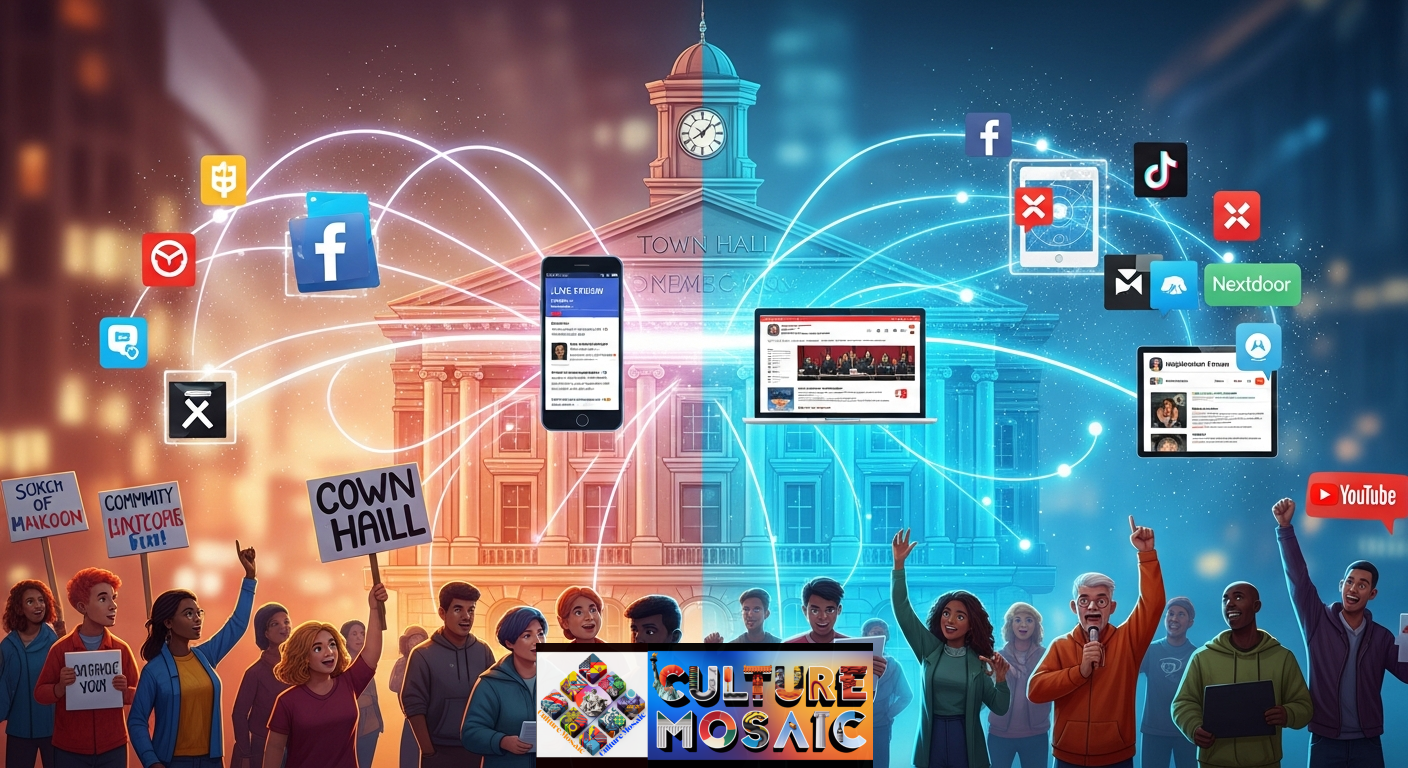The way Americans talk to their local governments has changed more in the past decade than in the previous century. Where we once relied on packed town halls and handwritten letters, we now scroll through Nextdoor threads about potholes, watch city council meetings on YouTube, and organize community movements in Facebook Groups before breakfast.
This shift isn’t just about convenience. Digital platforms and the future of civic voices are fundamentally connected because these tools are rewriting the rules of who gets heard, how quickly change can happen, and what it means to participate in democracy at the local level.
The question isn’t whether digital platforms matter to civic engagement anymore. It’s whether we’re using them wisely, and whether everyone has equal access to make their voice count.
The Digital Revolution in Local Civic Engagement
Walk into any city council meeting today and you’ll notice something different from ten years ago. Half the audience is filming on their phones. The other half isn’t there at all because they’re watching the livestream from home. And by tomorrow morning, the most controversial moments will be clipped, shared, and debated across a dozen different platforms.
This is what the intersection of digital platforms and the future of civic voices looks like in practice. It’s messy, immediate, and more accessible than ever before.
Traditional civic engagement required showing up physically during business hours, which automatically excluded working parents, people with disabilities, night-shift workers, and anyone without reliable transportation. Digital tools haven’t solved all these problems, but they’ve created new pathways for participation that didn’t exist before.
Platforms like Nextdoor have become virtual neighborhood watch programs where residents debate everything from proposed development projects to school board policies. Reddit’s local subreddits serve as unofficial town squares where younger residents who would never attend a city council meeting discuss municipal issues with surprising depth. Even TikTok, typically associated with dance trends, has become home to local activism breaking down complex zoning laws into 60-second explainers that reach thousands.
The numbers tell the story. A 2024 study by the Knight Foundation found that 68% of Americans under 35 say they first learn about local government transparency issues through social media rather than traditional news sources. Meanwhile, cities that offer multiple digital engagement options see participation rates 3-4 times higher than those relying solely on in-person meetings.
How Social Media Platforms Are Amplifying Civic Voices

The relationship between digital platforms and the future of civic voices becomes most visible when you look at specific cases where social media changed outcomes that traditional organizing couldn’t.
Take the story of a small Texas suburb where residents used a private Facebook Group to organize opposition to a proposed industrial facility near an elementary school. Within 48 hours, they had documented evidence, created information graphics, and mobilized 300 people to submit public comments. The facility was rejected. Five years ago, that same effort would have taken weeks and required significantly more resources.
Or consider how Instagram Stories have become an unexpected tool for civic accountability. When a city councilmember in Portland made a controversial vote, local activists used Instagram polls and question stickers to gather constituent opinions, then presented the results at the next council meeting. The visual, immediate nature of the platform made it easy for busy residents to participate in ways that attending a meeting never could.
Twitter (now X) threads have evolved into real-time fact-checking mechanisms during local government proceedings. When officials make claims about budget numbers or project timelines, engaged residents can now instantly verify and challenge those statements with supporting documentation, creating a level of transparency that would have been impossible in the pre-digital era.
These platforms work because they meet people where they already are. Americans spend an average of 2.5 hours daily on social media. By bringing civic issues into those spaces, rather than expecting everyone to come to government spaces, participation becomes frictionless.
But it’s not just about convenience. Digital platforms fundamentally change the power dynamics of civic engagement. A single mother working two jobs can now influence local policy while her kids are asleep. A resident with social anxiety can participate meaningfully without the stress of speaking in front of a crowd. Students can organize school board advocacy campaigns between classes using nothing but their phones.
The Dark Side: Misinformation and Digital Divides in Civic Spaces

Here’s the uncomfortable truth about digital platforms and the future of civic voices: the same tools that democratize participation also amplify misinformation, deepen polarization, and create new forms of exclusion.
Neighborhood apps like Nextdoor, while valuable for community organizing, have become breeding grounds for baseless rumors about local issues. A false claim about a proposed homeless shelter or affordable housing project can spread to thousands of residents before city officials even know there’s a problem. By the time the misinformation is corrected, many people have already formed strong opinions based on fiction.
The speed of digital communication creates what civic technology experts call the “outrage cycle.” A decontextualized clip from a city council meeting gets shared with inflammatory commentary, leading to hundreds of angry emails and calls to officials about something that never actually happened. Local governments now spend significant resources just correcting false narratives that spread faster than facts.
Then there’s the algorithm problem. Social media platforms are designed to maximize engagement, which means they prioritize controversial, emotional content over nuanced policy discussion. This creates perverse incentives where the most extreme voices on any local issue get amplified while thoughtful, moderate perspectives get buried. The result is civic conversations that feel more like shouting matches than community problem-solving.
The digital divide remains a serious barrier to truly democratic civic engagement. While 85% of Americans have internet access, that number drops significantly for low-income households, rural residents, and older adults. When local governments move engagement online without maintaining robust offline alternatives, they risk excluding the very communities most affected by policy decisions.
Age is a particularly significant factor. While younger generations naturally gravitate toward digital civic engagement, residents over 65—who often have the most available time to participate in local government—are least likely to use social media for civic purposes. This creates a participation gap where the digital future of civic voices might be inadvertently silencing some of our most engaged citizens.
Language access adds another layer of complexity. Most digital civic engagement happens in English, creating barriers for the millions of Americans who primarily speak other languages. Machine translation helps, but it’s not a complete solution, especially for complex policy discussions where nuance matters.
Successful Case Studies: Digital Platforms Transforming Local Democracy

Despite the challenges, compelling examples exist of communities using digital platforms to strengthen rather than undermine civic participation and truly shape the future of civic voices.
In Fort Collins, Colorado, the city government launched a mobile app called “Speak Up Fort Collins” that gamifies civic engagement. Residents earn points for attending (virtual or in-person) meetings, submitting comments on proposals, and completing civic education modules. The app has increased participation in local decision-making by 200%, with particularly strong engagement from demographics that traditionally had low participation rates.
The city of Boston created a “Digital Equity Coalition” that provides free tablets and internet access to low-income residents specifically for civic engagement purposes. They partnered with local libraries to offer training sessions on using digital tools to track city services, submit 311 requests, and participate in community meetings. Within two years, participation in public comment periods became more demographically representative of the actual city population.
In rural Kentucky, a coalition of small towns created a shared TikTok account where they post weekly updates about local government activities using relatable humor and local references. What started as an experiment has become the primary way residents under 40 learn about everything from road closures to budget priorities. The account now has 50,000 followers across a region with a population of 75,000.
Perhaps most innovatively, the city of Syracuse, New York, developed a partnership with local social media influencers to spread accurate information about civic processes. Rather than fighting the reality that many residents get their information from trusted community voices rather than official sources, they worked with those voices to ensure accuracy. When the city proposes a new policy, it briefs local influencers first, providing them with clear, shareable information to distribute through their networks.
These examples share common elements: they meet residents where they are, they remove barriers to participation, they build trust through transparency, and they recognize that the future of civic voices isn’t about choosing between digital and traditional engagement, but about creating multiple pathways for participation.
Practical Strategies: How Citizens Can Amplify Their Civic Voice Online

Understanding the connection between digital platforms and the future of civic voices is one thing. Actually using these tools effectively to influence your local government is another.
Start by identifying where your local civic conversations are already happening. This varies significantly by community. In some places, it’s a Facebook Group with 5,000 members. In others, it’s a local subreddit or a Nextdoor neighborhood. Find those spaces and spend time listening before jumping in. Understand the tone, the recurring concerns, and who the influential voices are.
When you do engage, focus on adding value rather than just expressing opinions. Share primary sources. Link to actual budget documents, meeting minutes, or planning documents. Digital civic engagement works best when it’s informative rather than just reactive. If you’re upset about a local decision, take the time to understand the full context before posting. You’ll be more persuasive, and you’ll help elevate the overall quality of civic discourse in your community.
Use visual communication strategically. A well-designed infographic about how your local budget gets spent will be shared far more widely than a wall of text making the same points. Short videos explaining complex zoning issues in plain language can reach people who would never read a planning commission report. You don’t need professional design skills—tools like Canva make it easy for anyone to create shareable civic content.
Build coalitions digitally before you need them. If you care about education policy, connect with other parents on social media now, before there’s a crisis. Create or join group chats focused on issues you care about. When something important comes up, you’ll have a ready-made network to mobilize rather than starting from scratch.
Learn your local government’s digital infrastructure. Most cities now have official apps, websites with public comment portals, and social media accounts. Follow them all. Set up alerts for agendas and meeting notices. The more information you have, the more effectively you can participate.
Document everything. If you attend a city council meeting (virtually or in person), take notes and share key points on social media afterward. If you submit a public comment, post it on your social channels too. This creates a public record and often inspires others to participate. It also signals to elected officials that people are paying attention.
Practice good digital citizenship. Call out misinformation when you see it, but do so respectfully and with sources. Acknowledge when you’re wrong. Engage with people you disagree with as potential allies rather than enemies. The future of civic voices depends on our ability to have hard conversations productively, and that starts with how we conduct ourselves online.
The Role of Local Government in Shaping Digital Civic Engagement

While citizens are adapting to digital platforms, local governments are still figuring out how to effectively incorporate these tools into their operations. The relationship between digital platforms and the future of civic voices won’t reach its full potential unless governments evolve alongside citizens.
Forward-thinking municipalities are creating dedicated social media positions focused specifically on civic engagement rather than just public relations. These aren’t marketing roles—they’re about facilitating genuine two-way communication between government and residents. The person in this position monitors local digital conversations, identifies emerging concerns, and helps translate complex policy issues into accessible content.
Some cities are experimenting with “digital town halls” that combine the reach of online platforms with the deliberative benefits of traditional meetings. Residents can submit and upvote questions in advance through an online portal, ensuring the most pressing concerns get addressed. The meetings are live-streamed with real-time moderation of digital comments and questions, creating a hybrid space that accommodates different participation preferences.
Transparency is becoming digitized in meaningful ways. Instead of requiring residents to file formal information requests, progressive cities are proactively publishing data on everything from police interactions to infrastructure spending to development applications. They’re not just dumping raw data either—they’re creating user-friendly dashboards and visualizations that make it easy for regular citizens to understand how their government works.
The best local governments are also tackling the misinformation problem head-on. Rather than pretending it doesn’t exist or dismissing it as someone else’s problem, they’re investing in rapid response capabilities. When false information about a local issue starts spreading, they can quickly deploy accurate information through multiple channels, often within hours rather than days.
Local election administration has also been transformed by digital platforms. Voter registration, sample ballot lookup, and information about candidates are now primarily accessed online. Many jurisdictions are experimenting with digital tools for signature gathering, comment submission, and even participatory budgeting, where residents can vote online about how certain funds get allocated.
However, responsible digital civic engagement from government requires serious attention to equity. Any digital tool must be supplemented with non-digital alternatives. Livestreamed meetings are great, but in-person options remain essential. Online comment portals are convenient, but phone and written comments must be equally weighted. The goal is to expand access, not replace one barrier with another.
Emerging Technologies and the Next Evolution of Civic Voices
Looking ahead, the relationship between digital platforms and the future of civic voices is about to get significantly more complex as new technologies enter the equation.
Artificial intelligence is already changing how citizens interact with local government. Chatbots can now answer basic questions about city services, helping residents navigate bureaucracy without waiting on hold or visiting offices during business hours. More sophisticated AI tools are being developed to help synthesize public comments, identifying common themes across thousands of submissions that would take humans weeks to analyze.
But AI also presents risks. Imagine a future where organized groups use AI to generate thousands of fake public comments on controversial issues, overwhelming genuine civic input. Or where deepfake videos of city officials spread misinformation faster than it can be debunked. Local governments are already discussing how to verify authentic participation in an age where AI can easily mimic human engagement.
Virtual and augmented reality could transform how residents visualize and respond to proposed changes in their communities. Instead of looking at architectural renderings of a proposed development, residents could explore it virtually, understanding exactly how it would look from their street. City planners could conduct virtual walking tours of proposed infrastructure changes, allowing residents to experience plans before they’re built.
Blockchain technology is being explored for civic applications like secure voting, transparent budget tracking, and immutable records of government decisions. While still experimental, these tools could address some of the trust issues that plague civic engagement by creating verifiable, tamper-proof records of government actions.
The metaverse, despite its uncertain future, presents interesting possibilities for civic engagement. Imagine virtual town halls where your avatar can interact with officials’ avatars in a digital recreation of your city’s council chambers, accessible to anyone with an internet connection, regardless of physical location or mobility limitations.
Whatever technologies emerge, the fundamental challenge remains the same: ensuring these tools genuinely expand participation rather than creating new forms of exclusion or manipulation. The future of civic voices depends not on technology itself, but on how we choose to implement it.
Digital platforms and the future of civic voices: Building a More Inclusive Digital Civic Future
The transformation of civic engagement through digital platforms is inevitable. The question is whether this transformation will strengthen democracy or weaken it.
The optimistic case is compelling. Digital platforms could give voice to people who have historically been excluded from civic processes. They could make government more responsive, transparent, and accessible. They could help communities organize, mobilize, and solve problems faster than ever before.
But this positive future isn’t guaranteed. Without intentional efforts to address digital divides, combat misinformation, and maintain space for nuanced deliberation, digital platforms could instead fragment communities, amplify extremism, and concentrate power among those with the most digital literacy and access.
The future of civic voices in a digital age requires conscious choices by governments, platforms, and citizens themselves. Governments must invest in digital equity while maintaining non-digital alternatives. Platforms must prioritize civic health over engagement metrics. And citizens must commit to using these powerful tools responsibly.
We’re living through a pivotal moment in democratic history. The relationship between digital platforms and the future of civic voices is still being written. The choices we make now—about access, about design, about norms and expectations—will shape civic life for generations.
The town hall hasn’t disappeared. It’s just expanded to include TikTok, Reddit, and Nextdoor alongside physical meeting rooms. Whether that expansion strengthens or weakens democracy depends on what we do next.
FAQs About Digital platforms and the future of civic voices
How do digital platforms improve civic engagement in local government?
Digital platforms lower barriers to participation by allowing residents to engage from home, at convenient times, and without the need for transportation. They enable quick information sharing, real-time dialogue with officials, and the ability to organize community action rapidly. Platforms also create permanent records of discussions and decisions that can be easily referenced later.
What are the biggest challenges facing digital civic engagement?
The primary challenges include the digital divide that excludes low-income and older residents, the rapid spread of misinformation, the algorithmic amplification of extreme viewpoints, and the difficulty of maintaining nuanced discussion in fast-moving online spaces. Additionally, ensuring equal weight is given to digital and in-person participation remains an ongoing challenge for local governments.
Which digital platforms are most effective for local civic engagement?
Effectiveness varies by community demographics, but Facebook Groups and Nextdoor are widely used for neighborhood-level organizing. Twitter/X works well for real-time government accountability. Instagram and TikTok increasingly reach younger residents who avoid traditional engagement channels. Purpose-built civic apps like Bang the Table or Polco offer structured engagement tools. The most effective approach typically involves multiple platforms rather than relying on just one.
How can I verify information about local government issues I see on social media?
Always check official government websites and social media accounts first. Most local governments publish meeting agendas, minutes, and public documents online. Contact the relevant government office directly to confirm details. Look for local news coverage from established outlets rather than relying solely on social media posts. When sharing information, include links to primary sources so others can verify for themselves.
What skills do citizens need to effectively engage civically on digital platforms?
Beyond basic social media literacy, effective digital civic engagement requires critical evaluation of information sources, understanding of how to navigate government websites and portals, ability to communicate clearly and respectfully in text-based formats, and knowledge of when digital engagement should be supplemented with phone calls, emails, or in-person participation. Visual communication skills—creating simple graphics or short videos—are increasingly valuable for reaching broader audiences with civic information.

